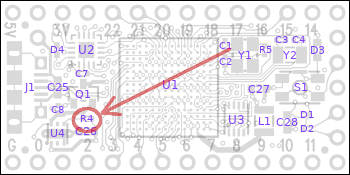All sorts of unrelated problems are possible with low quality DC-DC converters. Especially the very small ones tend to not have enough capacitance at the input and output. Some people (including folks at Adafruit) sometimes assume the answer to power supply problems is adding more capacitance at their output. Often this does help, especially in the scenario of a weak "wall wart" power supply with a long cable. But if the DC-DC converter has stability problems, as many of the small PCB mounted ones do, sometimes piling on more capacitance at the output without also adding a good quality capacitor close to the input can make matters even worse.
The Teensy 4.0 boards with the newer regulators and 100K are able to work with slow startup power supplies which eventually (usually over many milliseconds) do rise up to 5 volts. Slow rising input power is not a problem for those boards. They will turn on properly as the input voltage crosses about 4.0 to 4.1 volts. Removing or changing R4 won't have any change for handling of slowly rising power, other than the threshold where Teensy 4.0 enables its 3.3V regulator.
Probably the simplest way to test if your Teensy 4.0 has the original design (which starts up around 3.25 volts) or the new regulator with 100K resistor (4.0 to 4.1V startup) or the updated design with new regulator and 470K resistor (~3.2V startup) is to program your Teensy 4.0 with a LED blink or other easy-to-observe program and then connect it to lab bench power supply. First set it to 5V and make sure everything is working. Then dial it down to 3.6V and cycle the power. Then test again at 3.4V and other levels as you wish.
Attempting to measure R4 with an ohm meter is tricky. Multimeters in ohms mode transmit a test current through the leads and try to measure the resulting voltage. The specific current used can vary quite a lot with different brands of multimeters, and of course changes depending on the measurement range the it has configured. For higher resistance, the voltage across the resistor will be higher. With my old Fluke 87 multimeter, I can measure R4 at ~100K with all power shut off. But measuring a 470K resistor gives a strange-looking result because the voltage across the resistor becomes enough the much of the multimeter's test current starts flowing through the other parts on the PCB. I usually see it settle around 150K. The slowness of this process is probably due to the current flowing into some of the capacitors. As a general rule, measuring resistors while they're connected to other stuff is tricky, because your ohm meter's test current doesn't necessarily all flow through the resistor. It has plenty of other paths to take on the circuit board.
So back the original issue with your Pololu 2564 regulator. If it's also having trouble with Teensy 3.2 and Teensy 4.0, that's probably a sign you should try adding capacitors at both input and output. You might also try putting a switch (or just a wire you touch) between the Pololu+capacitors and Teensy, so you can compare the results of turning on the power to the regulator with Teensy connected versus letting the regulator fully start up and then connect Teensy to it.


